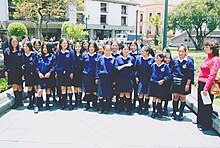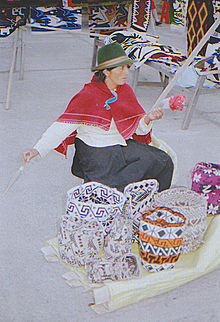What Are the Roles of Family Women and Men in Ecuador
| A portrait of a woman from Ecuador, 1867 | |
| Full general Statistics | |
|---|---|
| Maternal mortality (per 100,000) | 110 (2010) |
| Women in parliament | 38.seven% (2013) |
| Women over 25 with secondary education | 40.ane% (2012) |
| Women in labour force | 54.4% (2012) |
| Gender Inequality Index[1] | |
| Value | 0.384 (2019) |
| Rank | 86th out of 162 |
| Global Gender Gap Index[ii] | |
| Value | 0.739 (2021) |
| Rank | 42nd out of 156 |
Women in Ecuador are generally responsible for the upbringing and intendance of children and families; traditionally, men have not taken an active role. Ever more women accept been joining the workforce, which has resulted in men doing some housework, and becoming more than involved in the intendance of their children. This alter has been greatly influenced by Eloy Alfaro's liberal revolution in 1906, in which Ecuadorian women were granted the right to piece of work.[three] Women's suffrage was granted in 1929.
Girls tend to be more protected by their parents than boys, due to traditional social structures. Ecuadorian women on the other hand, seem to be less protected as they will face many bug, including domestic violence, poverty and lack of proper access to healthcare.
Poverty [edit]
Women, especially rural women, are disproportionately affected by poverty. Women are more likely to exist unemployed. In 2019, the unemployment rate for women in Ecuador was 5.0%, and male unemployment was 3.3%.[4] In 2012, the total labor strength was roughly 7.39 one thousand thousand people.[5] In comparison this means roughly 125,630 more women are going unemployed.
In 2013 the CDT stated in rural areas women fabricated $219 monthly, compared to men making $293 monthly, and in urban areas women fabricated $421 monthly, and men made $524 monthly.[6] According to this statistic, women are making roughly thirteen-26% less than men monthly. Labor force participation is also asymmetric in Ecuador, with women participating 56%, and men participating nearly 83%, thats a 27% gap in participation between each sex.[4]
Poverty and malnutrition are most probable to touch women, besides equally young children and ethnic populations. A study in 2014, constitute that nearly 23.9% of children under the historic period of 5 have been stunted in their growth due to malnutrition.[7] Discrimination based on ethnicity interacts with bigotry based on sex, resulting in very high levels of poverty for indigenous and black women.
Education [edit]


Spinning woman in a market in Ecuador
Girls traditionally have been less likely to be formally educated than men. Traditional gender roles lead women towards 'female jobs', such equally nursing and instruction, which are underpaid and under-appreciated.[8] Women still have a lower literacy rate than men: as of 2011, the literacy charge per unit was 90.ii% female person and 93.1% male.[9] In recent years, several programs have promoted instruction for the indigenous girls and women.[10]
The situation for indigenous people is worse. When it comes to educational attainment in 1999, while the number for not-ethnic females aged 12–65 was 8.0 years to complete the pedagogy, ethnic females had only 3.8 years. It ways that indigenous women tin can take less time to study compared to men. In terms of school enrollment rate, there is no big departure for primary school because of gender difference and indigenous or non, but indigenous females had much less lower-secondary and higher-secondary enrollment rates. For lower-secondary, indigenous females had only 10.08% while not-indigenous females had 59.79%.[11] These facts make it more difficult for indigenous people in Ecuador to get a job. In Kichwa's case, mestiza women tend to exist hired more than Kichwa women because many people assume that indigenous people are not "avant-garde." It is a mutual thought that mestiza are more than intelligent like WASPs.[12]
Social reproduction happens among women in Republic of ecuador in terms of education. According to Shenton'south interview, some women had attended a academy, own their own business, and they seek to let their daughters do what they did. Shenton stated that it is an obligation for educated people to provide their children with the pedagogy. They hope their children get educated and have more than possibilities for their life.[12]
Reproductive health [edit]
Poor data and access to contraceptive methods ofttimes atomic number 82 to unwanted pregnancies, especially amongst teenage girls and immature women.[viii] The maternal mortality rate in Ecuador is 110 deaths/100,000 live births (as of 2010).[13] The HIV/AIDS rate is 0.vi% for adults (anile 15–49), as of 2012 estimates.[14] Ballgame in Ecuador is illegal, with only few exceptions for special circumstances. According to a Human Rights Sentry report, legal abortion is unremarkably denied to women, even in the case of rape.[15] In recent years, being confronted with the highest teenage pregnancy charge per unit in South America, Republic of ecuador has decided to liberalize its policy regarding contraception, including emergency contraception.[16]
A study was conducted in 2017 to identify infectious diseases associated to preterm delivery. This study focused on the effects of the Zika virus on pregnant women. The study found that thirty-2 of the fifty-nine women tested were Zika positive.[17] They found that the virus was prevalent in the women'southward reproductive tract. The Zika virus has been linked with nascency defects in newborns. These defects include microcephaly, Guillain-Barré syndrome, and a weakened immune and nervous system.[eighteen]
Domestic violence [edit]
Domestic violence against women is a very serious problem.[8] La Ley Contra la Violencia a la Mujer y la Familia [19] (Law on Violence confronting Women and the Family) deals with domestic violence. This law was heavily influenced by the Consejo Nacional de las Mujeres CONAMU (National Council of Women) and by what they believe in and represent. A rough translation of their missions statement is to further enable our efforts and resources to create conditions of equality for women and to develop a society where women are included in economical, political, social, and cultural ways of life. The quango believes this can be achieved if we focus on creating a violence-free society, a society where women'due south physical and psychological well-being is protected.
A study was conducted with information from 2010 comparison adult female's wealth to domestic violence in Ecuador. They found that violence increased when the human being was the only source of income, and saw no pregnant relationship when the woman had higher wealth than the man.[20] In improver, a new Criminal Lawmaking came into force in 2014, which too addresses domestic violence.[21]
See likewise [edit]
- Human trafficking in Ecuador
References [edit]
- ^ "Gender Inequality Index" (PDF). HUMAN DEVELOPMENT REPORTS. Retrieved 27 October 2021.
- ^ "Global Gender Gap Report 2021" (PDF). World Economic Forum. Retrieved 30 November 2021.
- ^ Hazelton, Alan Weaver (1943). Eloy Alfaro, apostle of pan Americanism. hdl:2027/mdp.39015038679935. OCLC 4789844. [ page needed ]
- ^ a b "Gender Information Portal". datatopics.worldbank.org . Retrieved 2020-11-nineteen .
- ^ "Ecuador Labor Facts & Stats". www.nationmaster.com . Retrieved 2020-11-19 .
- ^ "Ecuador". United nations Women | Americas and the Caribbean area . Retrieved 2020-11-xix .
- ^ "Ecuador Diet Profile - Global Nutrition Report". globalnutritionreport.org . Retrieved 2020-11-19 .
- ^ a b c https://world wide web.united nations.org/womenwatch/daw/Review/responses/ECUADOR-English language.pdf[ full citation needed ]
- ^ "The Earth Factbook — Fundamental Intelligence Agency". www.cia.gov . Retrieved 16 Apr 2018.
- ^ "BBC NEWS - In pictures - Schoolhouse for Ecuador indigenous women". news.bbc.co.uk . Retrieved 16 April 2018.
- ^ García-Aracil, Adela; Wintertime, Carolyn (February 2006). "Gender and ethnicity differentials in school attainment and labor market earnings in Ecuador". Globe Development. 34 (2): 289–307. doi:10.1016/j.worlddev.2005.10.001.
- ^ a b Shenton, Jamie East. (2019). "Strong Kichwa Women are Made, Fabricated Upwardly, and Make Others: Feminist Theory Meets Amazonian Ethnography of Gender, Bodies, and Social Change". Anthropological Quarterly. 92 (i): 5–34. doi:10.1353/anq.2019.0000. S2CID 164848873.
- ^ "The World Factbook — Central Intelligence Agency". www.cia.gov . Retrieved 16 April 2018.
- ^ "The World Factbook — Central Intelligence Agency". www.cia.gov . Retrieved sixteen April 2018.
- ^ https://www.hrw.org/sites/default/files/reports/ecuador0813_ForUpload_1.pdf[ full citation needed ]
- ^ "Q&A: Ecuador Guarantees Right to Free Emergency Contraception - Inter Press Service". www.ipsnews.net . Retrieved 16 April 2018.
- ^ Zambrano, Hector; Waggoner, Jesse; León, Karina; Pinsky, Benjamin; Vera, Ketty; Schettino, Marissa; Rivera, Lisette; Landivar, José; Granda, María; Lee, Angela; Mor, Gil (February 2017). "High incidence of Zika virus infection detected in plasma and cervical cytology specimens from pregnant women in Guayaquil, Ecuador". American Journal of Reproductive Immunology. 77 (two): e12630. doi:10.1111/aji.12630. PMID 28177195. S2CID 206988134.
- ^ Fifty. Casapulla, Sharon; Aidoo-Frimpong, Gloria; B. Basta, Tania; J. Grijalva, Mario (2018). "Zika virus knowledge and attitudes in Republic of ecuador". AIMS Public Health. 5 (ane): 49–63. doi:10.3934/publichealth.2018.1.49. PMC6070462. PMID 30083569.
- ^ http://pdba.georgetown.edu/Security/citizensecurity/republic of ecuador/leyes/leyviolenciamujer.pdf[ full citation needed ]
- ^ Oduro, Abena (2 April 2015). "Women's Wealth and Intimate Partner Violence: Insights from Ecuador and Republic of ghana". Feminist Economics. 21 (2): 1–29. doi:10.1080/13545701.2014.997774. S2CID 154897376.
- ^ http://www.asambleanacional.gob.ec/organisation/files/document.pdf[ full commendation needed ]
External links [edit]
- Ecuadorian Women March in Defense of the Amazon
- Characteristics of typical Ecuadorian woman
Source: https://en.wikipedia.org/wiki/Women_in_Ecuador#:~:text=Women%20in%20Ecuador%20are%20generally,the%20care%20of%20their%20children.
0 Response to "What Are the Roles of Family Women and Men in Ecuador"
Post a Comment